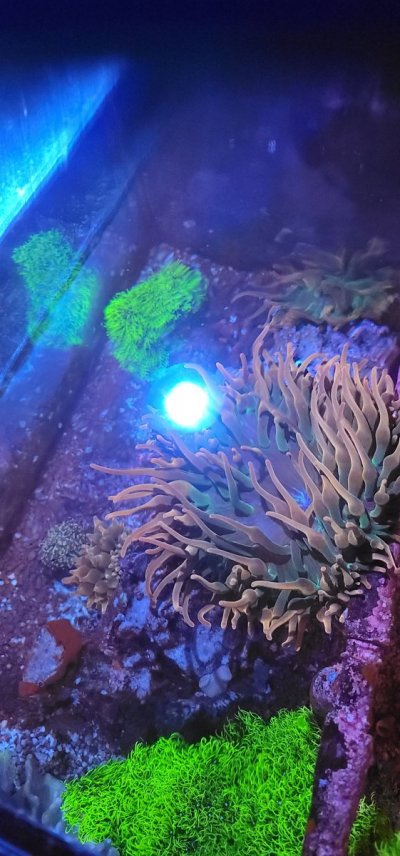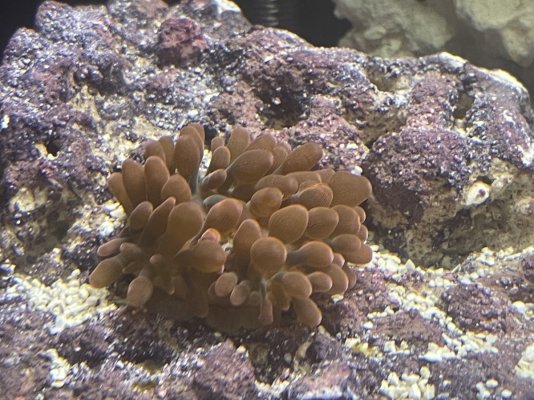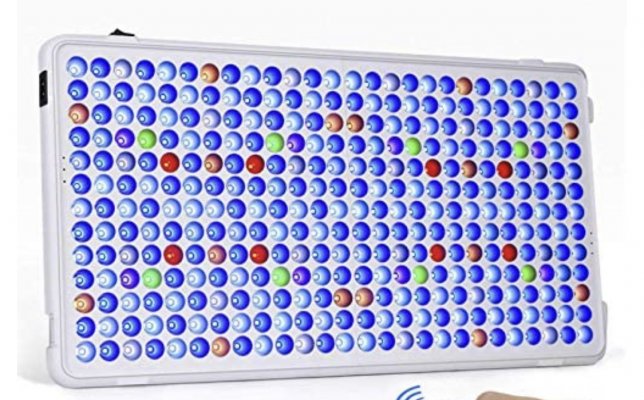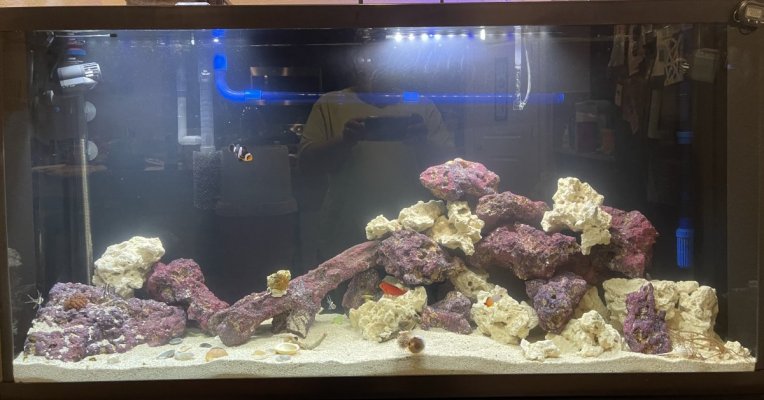Navigation
Install the app
How to install the app on iOS
Follow along with the video below to see how to install our site as a web app on your home screen.
Note: This feature may not be available in some browsers.
More options
You are using an out of date browser. It may not display this or other websites correctly.
You should upgrade or use an alternative browser.
You should upgrade or use an alternative browser.
Worried about my bubble tip
- Thread starter christyahumada
- Start date
- Tagged users None
What’s the issue? Looks healthy to me , anemones will sometimes deflate periodically to use restroom or change of lighting / acclimating
It doesn’t look totally happy/healthy to me, but without more info we can’t offer any help. Is it like this all the time? What are your parameters? How old is the tank? How long have you had the anemone? Are you feeding it, and if so what and how much? What kind of lighting do you have? Need more info about the problem and about your tank/parameters.
It doesn’t look totally happy/healthy to me, but without more info we can’t offer any help. Is it like this all the time? What are your parameters? How old is the tank? How long have you had the anemone? Are you feeding it, and if so what and how much? What kind of lighting do you have? Need more info about the problem and about your tank/parameters
I’ve had it for 2 days now. It jut did that this evening. I’m new to all of this so I have the lighting that came with the tank but I’m waiting on the new ones to come in. My ammonia, nitrate and nitrite are all 0 and my PH is 8.2. I think I need to get some more testing kits though
It likes my refugium thoughI’ve had it for 2 days now. It jut did that this evening. I’m new to all of this so I have the lighting that came with the tank but I’m waiting on the new ones to come in. My ammonia, nitrate and nitrite are all 0 and my PH is 8.2. I think I need to get some more testing kits though
It just had some of its tentacles smaller and I didn’t know if something might have been wrong with it.What’s the issue? Looks healthy to me , anemones will sometimes deflate periodically to use restroom or change of lighting / acclimating
Jekyl
GSP is the devil and clowns are bad pets
View BadgesHospitality Award
Midwest Reefer
Fish Medic
Anemone are fickle creatures. They prefer strong lighting and an established tank. Depending on who you ask anywhere from 4 months to a year of the tank maturing before getting one. Finding out exactly what light you are using and possibly adding some established live rock will help you out. First week or 2 generally they do their thing. After then is when signs of discomfort will present themselves.I’ve had it for 2 days now. It jut did that this evening. I’m new to all of this so I have the lighting that came with the tank but I’m waiting on the new ones to come in. My ammonia, nitrate and nitrite are all 0 and my PH is 8.2. I think I need to get some more testing kits though

Last edited:
Right now it’s on a live rock but I am using the led light that came with the tank. I’m waiting for my other light to come in.Anemone are fickle creatures. They prefer strong lighting and an established tank. Depending on who you ask anywhere from 4 months to a year of the tank maturing before getting one. Finding out exactly what light you are using and possibly adding some established live rock will help you out. First week or 2 generally they do there thing. After then is when signs of discomfort will present themselves.
I agree with you here.... of course somebody gonna come yell at us both in a minute, for suggesting they prefer established tanks. So be it....Anemone are fickle creatures. They prefer strong lighting and an established tank. Depending on who you ask anywhere from 4 months to a year of the tank maturing before getting one. Finding out exactly what light you are using and possibly adding some established live rock will help you out. First week or 2 generally they do there thing. After then is when signs of discomfort will present themselves.
Eventually, but with these kits at least you have a starter.... what is the lighting that is with tank , and what is the new stuff going to be?I’ve had it for 2 days now. It jut did that this evening. I’m new to all of this so I have the lighting that came with the tank but I’m waiting on the new ones to come in. My ammonia, nitrate and nitrite are all 0 and my PH is 8.2. I think I need to get some more testing kits though
Jekyl
GSP is the devil and clowns are bad pets
View BadgesHospitality Award
Midwest Reefer
Fish Medic
I can't speak to others experiences only my own. Personally I had a horrible time with anemone until my tank was around 9 months old. Now with a 4 year old tank they thrive. I have 4 nems right now all growing like crazy. Biggest is over 12" across.I agree with you here.... of course somebody gonna come yell at us both in a minute, for suggesting they prefer established tanks. So be it....
The led strips with the blue and white.Eventually, but with these kits at least you have a starter.... what is the lighting that is with tank , and what is the new stuff going to be?
Aquarium Light with Remote Control, 300W Dimmable LED Coral Reef Light for Saltwater Freshwater Fish Tanks with Timer 6/12/18 Function
Attachments
I would echo what everyone else has said , generally anemone require mature tanks older than 9 months or so and very strong lighting , I’m not sure about yr light you posted what size is the tank?
Jekyl
GSP is the devil and clowns are bad pets
View BadgesHospitality Award
Midwest Reefer
Fish Medic
Have a link to the actual light or the maker? Generally 300w should be fine though. I would do some research on it to find out the best settings and schedule for it. You said you have live rock.. now does that mean you purchased it still wet from an established tank? Or was it dry rock?
It was dry live rock. I’ll see if I can find the websiteHave a link to the actual light or the maker? Generally 300w should be fine though. I would do some research on it to find out the best settings and schedule for it. You said you have live rock.. now does that mean you purchased it still wet from an established tank? Or was it dry rock?
vetteguy53081
Well known Member and monster tank lover
View Badges
Partner Member 2024
Excellence Award
Reef Tank 365
RGB
Article Contributor
Tampa Bay Reef Keepers
West Palm Beach Reefer
Hospitality Award
Ocala Reef Club Member
305 Reef Club
Wisco Reefers
Midwest Reefer
Fish Medic
MAC of SW Florida
Rock Pool Reef Keepers
R2R Secret Santa 2023
My Tank Thread
My Aquarium Showcase
Get it off the sandbed. Tank looks failrly new in which a BTA is not a best choice.
They’re not as easy to own as many people think. Thanks to the symbiotic relationship they form with certain fish, they are a joy to watch and care for. This species splits and propagates very easily in the right conditions, resulting in large captive populations.
The length of the tentacles can vary. The same goes for the size and shape of the bulb. With some specimens, the bulb is accompanied by a small tip. Interestingly enough, the tentacles can change based on the anemone’s environment. Below the splay of tentacles is the anemone’s foot. The foot is delicate. Yet, it has simple muscle fibers that help the creature move and anchor onto rocks.
Rose Bubble Tip Anemones are, by far, the most common type you’ll see on the market. They’re prolific propagators, which undoubtedly contributes to their popularity. This type is quite affordable and is a good option for first-time anemone owners. Rainbow bubble Tip Anemone that’s usually considered to be exotic.
proper Bubble Tip Anemone care requires a bit of work to keep these creatures healthy! In short, theyre not recommended for first-time aquarists. Having thorough knowledge about these animals is a must. The invertebrates are sensitive to water changes and require pristine conditions to stay in good shape. Failing to meet their needs can result in early death and damage to the tank environment as a whole. Yes, getting caught in a power head is a concern but rarely occurs.
The most important thing you’ll need to take care of before you bring your anemone home is perfecting the tank and water conditions. You should never place a Bubble Tip Anemone into a tank you just set up.
Take some time to get parameters just right and let the closed environment cycle for a few months. This ensures that conditions are stable and safe. Bubble Tip Anemones prefer warmer temperatures. Water should be on the alkali side as well. Monitor water conditions regularly to avoid any major changes. Ammonia and nitrate levels should be undetectable at all times using a good quakity test kit and Not API either.
Here are some water parameters to follow.
If it starts to move towards any coral, simply direct your water jets to the coral. This will discourage the anemone from anchoring near it. It will move to another area to attach.
Bubble Tip Anemone lighting is a very important aspect of their care. These creatures need a lot of light to thrive because they’re photosynthetic which means that they absorb light to produce food and growth. The anemone has zooxanthellae in its body, which are symbiotic microorganisms that they feed on. Without proper lighting, the anemone will expel the zooxanthellae and turn white. This process is called bleaching and often leads to death.
A moderate amount of flow is recommended. Many aquarists agree that too much flow will cause the anemone to stretch out and look stringy. Keeping things moderate will help avoid this from happening. Avoid directing your flow directly at the anemone. These creatures enjoy subtle movement at all times but too much direct flow hitting the anemone will force it to move.
Lastly- Feeding.
Bubble Tip Anemones feeding is one of the easiest parts of their care. These animals get food from a lot of different sources. As mentioned earlier, they are photosynthetic and use light to create food. They will also eat food off of the fish they host. These anemones enjoy small morsels of shrimp and squid. They will also accept many frozen foods. To feed the anemone, attach the food to a stick or large tweezers. Then, touch the anemone with it. The creature will use its tentacles to grab onto the food and consume it. twice a week feedings is ample.
They’re not as easy to own as many people think. Thanks to the symbiotic relationship they form with certain fish, they are a joy to watch and care for. This species splits and propagates very easily in the right conditions, resulting in large captive populations.
The length of the tentacles can vary. The same goes for the size and shape of the bulb. With some specimens, the bulb is accompanied by a small tip. Interestingly enough, the tentacles can change based on the anemone’s environment. Below the splay of tentacles is the anemone’s foot. The foot is delicate. Yet, it has simple muscle fibers that help the creature move and anchor onto rocks.
Rose Bubble Tip Anemones are, by far, the most common type you’ll see on the market. They’re prolific propagators, which undoubtedly contributes to their popularity. This type is quite affordable and is a good option for first-time anemone owners. Rainbow bubble Tip Anemone that’s usually considered to be exotic.
proper Bubble Tip Anemone care requires a bit of work to keep these creatures healthy! In short, theyre not recommended for first-time aquarists. Having thorough knowledge about these animals is a must. The invertebrates are sensitive to water changes and require pristine conditions to stay in good shape. Failing to meet their needs can result in early death and damage to the tank environment as a whole. Yes, getting caught in a power head is a concern but rarely occurs.
The most important thing you’ll need to take care of before you bring your anemone home is perfecting the tank and water conditions. You should never place a Bubble Tip Anemone into a tank you just set up.
Take some time to get parameters just right and let the closed environment cycle for a few months. This ensures that conditions are stable and safe. Bubble Tip Anemones prefer warmer temperatures. Water should be on the alkali side as well. Monitor water conditions regularly to avoid any major changes. Ammonia and nitrate levels should be undetectable at all times using a good quakity test kit and Not API either.
Here are some water parameters to follow.
- Water temperature: Between 77°F and 82°F (stay close to the middle of this range)
- pH level: 8.1 to 8.4
- Water hardness: 8 to 12 dKH
- Specific gravity: 1.024 to 1.025
- Nitrate < .5
If it starts to move towards any coral, simply direct your water jets to the coral. This will discourage the anemone from anchoring near it. It will move to another area to attach.
Bubble Tip Anemone lighting is a very important aspect of their care. These creatures need a lot of light to thrive because they’re photosynthetic which means that they absorb light to produce food and growth. The anemone has zooxanthellae in its body, which are symbiotic microorganisms that they feed on. Without proper lighting, the anemone will expel the zooxanthellae and turn white. This process is called bleaching and often leads to death.
A moderate amount of flow is recommended. Many aquarists agree that too much flow will cause the anemone to stretch out and look stringy. Keeping things moderate will help avoid this from happening. Avoid directing your flow directly at the anemone. These creatures enjoy subtle movement at all times but too much direct flow hitting the anemone will force it to move.
Lastly- Feeding.
Bubble Tip Anemones feeding is one of the easiest parts of their care. These animals get food from a lot of different sources. As mentioned earlier, they are photosynthetic and use light to create food. They will also eat food off of the fish they host. These anemones enjoy small morsels of shrimp and squid. They will also accept many frozen foods. To feed the anemone, attach the food to a stick or large tweezers. Then, touch the anemone with it. The creature will use its tentacles to grab onto the food and consume it. twice a week feedings is ample.
Unfortunately it is dry rock , live rock is old and mature and seeded with Bacteria / micro fauna that helps stabilize a tank - anemones love stability and with dry rock you will be going through various cycles not including the nitrogen cycle which could affect the health of the anemone , as lighting I would recommend the vivaspextra 300watt black box it is budget friendly and wil be able to provide the necessary lightIt was dry live rock. I’ll see if I can find the website
It’s not on the sand bed. It’s on the purple rock on the left. Thank you for this info. I was getting mixed info from where I was getting my information. My nitrate, nitrite and ammonia is all reading 0. PH is 8.2. Temp is staying around 78.6. My gravity is at 1.023 so I need to bring that up. As for the hardness I don’t know. I will have to get a better testing kit to get all of that.Get it off the sandbed. Tank looks failrly new in which a BTA is not a best choice.
They’re not as easy to own as many people think. Thanks to the symbiotic relationship they form with certain fish, they are a joy to watch and care for. This species splits and propagates very easily in the right conditions, resulting in large captive populations.
The length of the tentacles can vary. The same goes for the size and shape of the bulb. With some specimens, the bulb is accompanied by a small tip. Interestingly enough, the tentacles can change based on the anemone’s environment. Below the splay of tentacles is the anemone’s foot. The foot is delicate. Yet, it has simple muscle fibers that help the creature move and anchor onto rocks.
Rose Bubble Tip Anemones are, by far, the most common type you’ll see on the market. They’re prolific propagators, which undoubtedly contributes to their popularity. This type is quite affordable and is a good option for first-time anemone owners. Rainbow bubble Tip Anemone that’s usually considered to be exotic.
proper Bubble Tip Anemone care requires a bit of work to keep these creatures healthy! In short, theyre not recommended for first-time aquarists. Having thorough knowledge about these animals is a must. The invertebrates are sensitive to water changes and require pristine conditions to stay in good shape. Failing to meet their needs can result in early death and damage to the tank environment as a whole. Yes, getting caught in a power head is a concern but rarely occurs.
The most important thing you’ll need to take care of before you bring your anemone home is perfecting the tank and water conditions. You should never place a Bubble Tip Anemone into a tank you just set up.
Take some time to get parameters just right and let the closed environment cycle for a few months. This ensures that conditions are stable and safe. Bubble Tip Anemones prefer warmer temperatures. Water should be on the alkali side as well. Monitor water conditions regularly to avoid any major changes. Ammonia and nitrate levels should be undetectable at all times using a good quakity test kit and Not API either.
Here are some water parameters to follow.
When you first introduce the anemone to the tank, turn down any pumps. The flow should be minimal until the anemone gets settled in. Chances are, your new Bubble Tip Anemone will move around the tank until it finds a suitable spot to call home.
- Water temperature: Between 77°F and 82°F (stay close to the middle of this range)
- pH level: 8.1 to 8.4
- Water hardness: 8 to 12 dKH
- Specific gravity: 1.024 to 1.025
- Nitrate < .5
If it starts to move towards any coral, simply direct your water jets to the coral. This will discourage the anemone from anchoring near it. It will move to another area to attach.
Bubble Tip Anemone lighting is a very important aspect of their care. These creatures need a lot of light to thrive because they’re photosynthetic which means that they absorb light to produce food and growth. The anemone has zooxanthellae in its body, which are symbiotic microorganisms that they feed on. Without proper lighting, the anemone will expel the zooxanthellae and turn white. This process is called bleaching and often leads to death.
A moderate amount of flow is recommended. Many aquarists agree that too much flow will cause the anemone to stretch out and look stringy. Keeping things moderate will help avoid this from happening. Avoid directing your flow directly at the anemone. These creatures enjoy subtle movement at all times but too much direct flow hitting the anemone will force it to move.
Lastly- Feeding.
Bubble Tip Anemones feeding is one of the easiest parts of their care. These animals get food from a lot of different sources. As mentioned earlier, they are photosynthetic and use light to create food. They will also eat food off of the fish they host. These anemones enjoy small morsels of shrimp and squid. They will also accept many frozen foods. To feed the anemone, attach the food to a stick or large tweezers. Then, touch the anemone with it. The creature will use its tentacles to grab onto the food and consume it. twice a week feedings is ample.
Jekyl
GSP is the devil and clowns are bad pets
View BadgesHospitality Award
Midwest Reefer
Fish Medic
I see it on the rock there. Don't be hands on with it. Focus on the correct parameters, lighting and flow. Once you think you have those correct, focus on stability and repetition. Do not get hands on with your anemone. They can move and hide. Any attempt by you to change where it is will cause more stress. Only time for you to put your hands on it would be if it's floating freely, about to go in a power head, or has the look of deteriorating. They will inflate and deflate. My 12" nem can deflate to the size of a mouthfull of big league chew.It’s not on the sand bed. It’s on the purple rock on the left
Similar threads
- Replies
- 1
- Views
- 75
- Replies
- 2
- Views
- 117
- Replies
- 3
- Views
- 98
- Replies
- 9
- Views
- 277
- Replies
- 2
- Views
- 124
New Posts
-
-
-
EMERGENCY Amphiprion ocallaris fins disease
- Latest: vetteguy53081
-




















